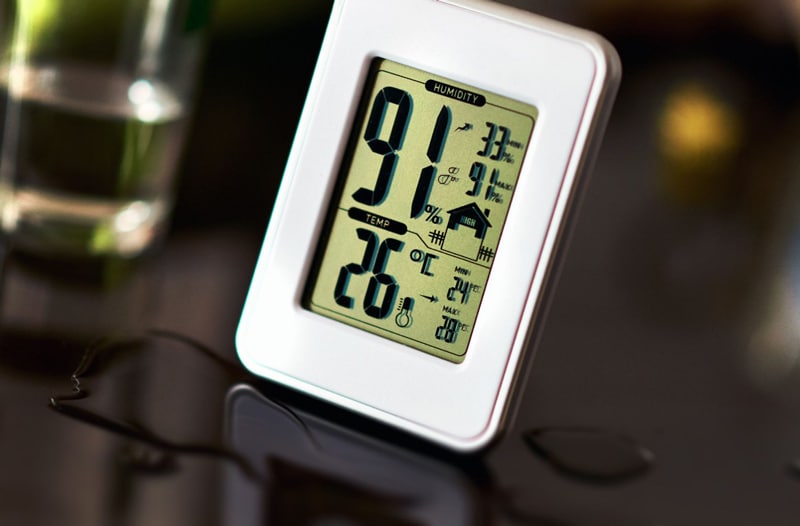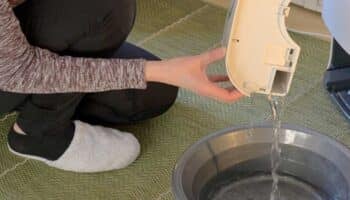Is your dehumidifier not shutting off when full? A faulty microswitch is likely to blame. Here are 5 fixes to try.
Few things can grind my gears like a dehumidifier that won’t shut off when it’s full. It starts off like a seemingly unimportant problem, but as time goes by, your home starts looking like a pond due to all the puddles and leaks.
If this sounds familiar to you, chin up. You might have bought an appliance that is supposed to serve two purposes. Remove excess ambient moisture, and provide you with a steady supply of water.
What a nice feature!
On a more serious note, though, you don’t want to drink that water. I’m sure you are in desperate need of answers, as a failing dehumidifier can have catastrophic consequences.
This is why I’ve prepared the list below, where you will find the most common causes to this occurrence, and the simplest steps you can take to address each one of them. Rest assured that, if you follow them to a tee, your dehumidifier will be back to its former glory in a jiffy.
Are you ready? Let’s get busy!
Fixing an Unresponsive Dehumidifier
#1 Reset the Appliance
Perhaps all your appliance needs is a hard rest
I want to start off this list by trying something simple, but that might solve all your problems. It’s a long shot, but there’s always the possibility that all your dehumidifier needs, is a little resetting.
You’d be surprised at how many people spend copious amounts of money every year trying to find what’s wrong with their unit, only to discover too late, that there were no technical faults in it whatsoever.
I want to keep you from becoming a part of this statistic, so let’s try this first.
Solution: Depending on your make and model, your dehumidifier might be equipped with a reset button. Holding that down until the dehumidifier beeps (or for about 5 seconds) may do the trick. However, don’t worry if it’s not, you haven’t run out of options.
Assuming that your appliance does not have this feature, you can also reset it by carefully unplugging it from the wall outlet, waiting 10 minutes, and plugging it back in.
If your machine’s automatic deactivation features were being affected by any kind of programming bug, this should resolve the problem.
#2 Defrost the Coils
Suboptimal operating temperatures could be causing your appliance to fail
It might not seem like it, but your dehumidifier needs to be operated under very specific temperatures in order to function adequately. Most manufacturers will recommend a minimum temperature of 65 degrees Fahrenheit to keep the coils in the unit from freezing.
Now, what are the coils, exactly?
I won’t bore you with the technical details, but in a nutshell, your machine is equipped with two of them, one that runs hot, and one that runs cold. The latter condenses the excessive humidity present in the air, while the former warms it up, and releases a drier current into your room.
When you operate your appliance below the recommended environmental temperatures, the cold coil can become icy. This can hinder the entire dehumidification process, and prevent the unit from shutting off as it normally would.
Solution: As stated previously, the best thing you can do to prevent this from happening is to make sure you’re keeping the room above the minimum 65 °F, but cleaning the coils regularly will also help.
In order to access these components, all you have to do is remove the frontal plastic panel and the filter, and then undo a couple of protective screws.
Once you can work on the coils, you can use a clean rag to wipe off any dust collected on them, and do this every month, or so.

#3 Replace the Microswitch
A faulty microswitch could have rendered your unit incapable of sensing a full reservoir
How exactly can your dehumidifier tell when the reservoir is full?
Simple, with the help of its microswitch.
This component is responsible for detecting the water level in the container, and prompting the appliance to shut off when it’s about to exceed the recommended capacity.
When the microswitch is working normally, your dehumidifier should shut off when full. However, when this part fails, the machine is rendered unable to detect the water levels inside it, thus causing your current situation.
Solution: I know how I made this part sound extremely important (and it is), but you’ll be glad to hear that it’s also the second-simplest repair on this list.
In most models, you will find this component right next to the reservoir, it should look like a small switch or button. Normally you’ll have to undo a couple of screws to detach it and gain comfortable access to it.
Once you have done that, bring out your trusty multimeter (if you have one), and test the microswitch for continuity. Provided that you get null readings on the meter, you’ll have to replace the part.
But don’t sweat it! You should be able to easily get a new switch either from your nearest hardware store, or your manufacturer.
If you want to get any replacement part – or see how much one would cost – click to enter your model number in the search bar below. Our partners at AppliancePartsPros stock almost every part with free guides on how to install them.

#4 Change the Humidity Levels
Your settings might be too low
What if I told you that you’ve been setting your humidity levels wrong all along?
I know what you’re thinking. “This would never happen to me because it’s too obvious”. But remember that it’s the most seemingly unimportant factors, that we tend to overlook more often.
If your dehumidifier is not shutting off when full, there’s a very good chance that you’re setting the humidity levels too low, causing the machine to keep running to reach the desired percentage.
The right settings will depend greatly on where you live and on your personal preferences. That being said, remember that an excessively dry room can also be bad for your health.
Solution: You’ll have to go through a little trial and error. Although your user manual should have some recommended specifications, they’re not perfect.
The best settings for your particular situation will always be determined by you, just make sure they’re not too low.
#5 Replace the Humidistat
Without your humidistat, your dehumidifier would be nothing but an expensive doorstop.
This component is solely responsible for detecting the humidity in your room and regulating the appliance’s settings accordingly in order to reach the desired results. When it works normally, it should follow your indications, but when it malfunctions, it could be sensing extreme humidity, even in a dry room.
If your dehumidifier is not shutting off when it’s full, there’s a very good chance that your humidistat is faulty, and needs urgent replacing.
Solution: If you’ve tried the previous solutions, you’ve already exposed your machine’s internal components, including the humidistat, so, half the work has already been taken care of.
Carefully remove this part from your dehumidifier and use a multimeter to test it for continuity, and viability.
Just as it happens with your other components, should the humidistat require replacing, you can get a new one either from your nearest hardware store or your manufacturer.

When Should You Call a Pro?
Check your warranty and find the best solution for your problem
The answer to this question will depend greatly on the status of your warranty and whether the items above solved your problem.
If you are still under coverage and don’t mind waiting a couple of days or weeks for your manufacturer to send a technician, by all means, go ahead and give them a call. Unless specified otherwise, they should be able to take care of the repairs for free.
Alternatively, if your warranty has expired, you’ll have to weigh the cost of repairs vs the cost of a new model. The spare parts to fix your dehumidifier are not awfully expensive, but the cost of labor to have them installed and configured, can be.
As a general rule, paying for repairs equal to 50% or more of the price of a new model with similar features, is a bad investment.
Conclusion
To have your dehumidifier malfunction can be a nightmare. Not only are you stuck with a useless appliance, but also in the uncomfortable position of having to find out what the problem is, and figuring out a way to fix it.
Fortunately, as I hope you’ve learned in this piece, addressing most of the causes behind this issue is fairly simple. More often than not, resetting the appliance, and making sure that you’re setting your humidity levels correctly, is all you need to do to keep it working perfectly.
Trust in yourself and in your DIY skills. I’m sure there’s nothing you can’t accomplish if you set your mind to it.
Thank you so much for sticking with me all the way to the end. If you found this article helpful, why not keep the learning going through our other incredible resources below?
Happy DIY’s!







